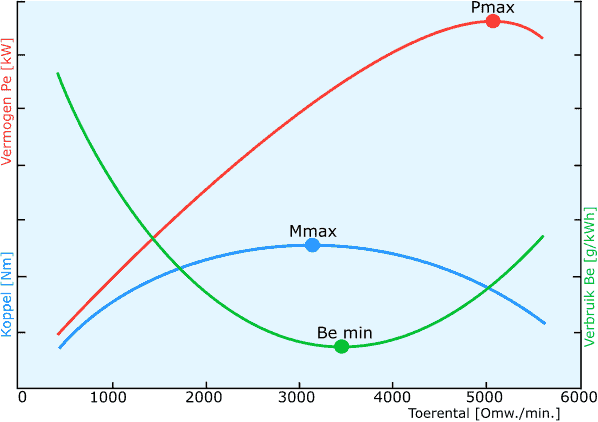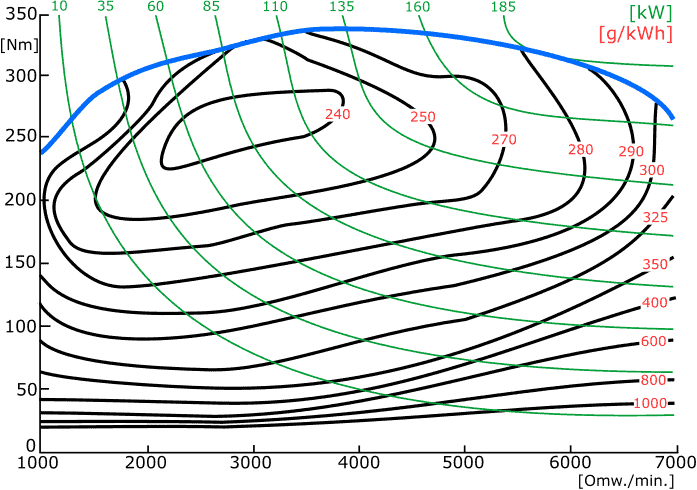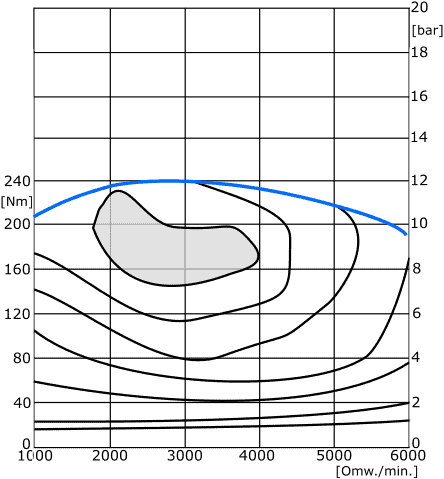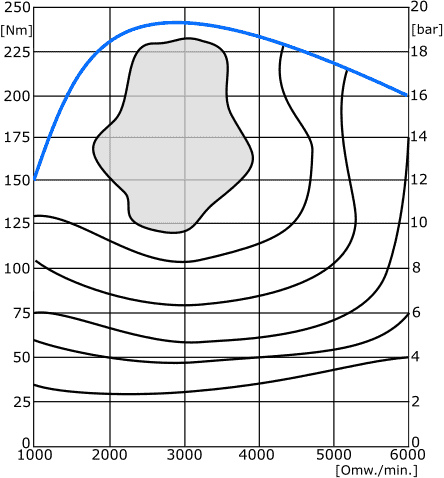Subjects:
- Specific fuel consumption
- Engine efficiency
- Power Diagram / Egg Diagram
- Power diagram on downsizing
Specific fuel consumption:
We usually express the fuel consumption of a vehicle in the number of kilometers driven per litre, eg: 1:15. In the vehicle documentation, liters per 100 km are often given. This takes into account the driving conditions, i.e. the driving resistances that play a major role.
It is interesting for technicians to know how much fuel it takes to deliver a certain amount of power over a period of time. This consumption is expressed in kilograms of fuel per hour (B). When we look at it per kiloWatt we talk about the specific fuel consumption (be), expressed in g/kWh.
The specific fuel consumption can be taken into account in the vehicle's torque-power diagram. This diagram shows that the specific fuel consumption under full load conditions is the last when the engine torque is just over its maximum.

Engine efficiency:
The lowest specific fuel consumption is obtained in the conditions where the engine efficiency is highest. Power is expressed in Watts or Joules/s. The supplied power is the heat content of the fuel, which is equal to the specific fuel consumption (be) * the delivered power (P) * the specific heat of combustion (H).
Power Diagram / Egg Diagram:
In the test phase of every (new) engine, a measurement for the specific fuel consumption takes place. In this measurement, the fuel consumption is performed on an engine test stand or dynamometer under different speeds at variable engine loads. The load is set by gradually depressing the accelerator pedal, so that the engine delivers several kW more power with each step. In this way the entire rev range is covered.
The image below shows the fuel consumption chart, also known as the “egg chart”. The islands indicate the fuel consumption in g/kWh. These lines (egg-shaped) connect the points whose specific fuel consumption is equal. The smallest island gives at a speed of around 3000 rpm. the lowest fuel consumption, namely 240 g/kWh. We call this the “sweet spot”. At such speed and load, the engine is the most economical.

Explanation of the lines in the Egg diagram:
- Vertical axis: the torque in Nm;
- Horizontal axis: crankshaft speed;
- Blue line: the torque curve of the motor;
- Green lines: power lines in kW;
- Black Isles: The Consumption Areas
The (green) power lines clearly show that with decreasing speed, the torque (and therefore the average combustion pressure) must increase in order to maintain the same power. We also see a decrease in fuel consumption. The minimum fuel consumption of 240 grams per kWh is obtained at a speed of around 3000 rpm with a delivered power of approximately 85 kW. The fuel consumption of this car is on average 9 l/100 km.
This means that the engine is most economical when it has to deliver about 45% of the total power. At lower powers, the motor is inefficient: virtually no power is delivered, but all internal friction losses must be accommodated. In practice, this can mean that the vehicle can be more economical when traveling at 120 km/h in 6th gear than when driving at 90 km/h in 4th gear.
Power diagram at downsizing:
Until recently, manufacturers used engines with large cylinder capacities. In the VAG group, the 6.0 (W-) 12-cylinder engine was the showpiece in, among others, the Audi A8 and the BMW M5 (E60) offered high performance with the naturally aspirated 5 liter V10 engine. The middle class cars were also equipped with a relatively large engine capacity, for example a naturally aspirated 2.0 liter. Today, manufacturers are looking for every possible way to drastically reduce emissions without sacrificing performance. We see the cylinder capacity of more and more engines becoming smaller and an exhaust gas turbo ensures good performance. We see an example of this in the VW Golf, where the 1.0 liter engine with turbo performs better and is more economical than an (older) 1.4 liter engine without turbo:
- VW Golf V from 2005, cylinder capacity: 1,4 liter, power: 59 kW, consumption: 6,9 l/100km (1:14.5);
- VW Golf VII from 2015, cylinder capacity: 1.0 liter, power: 85 kW, consumption: 4,5 l/100km (1:22,2).
The egg diagrams below are from a atmospheric engine with a displacement of 2,5 liter and an pressurized 1,6 liter engine. Both engines deliver a maximum torque of 240 Nm. The torque curve of the naturally aspirated engine is a lot flatter than with the turbo engine around 3000 rpm. With both engines the maximum torque is reached at about 3000 rpm, only we see that the medium effective piston pressure (BMEP) is 7 bar higher for the turbo engine at the torque speed. A higher BMEP leads to less flow losses during the gas exchange and a higher efficiency.


